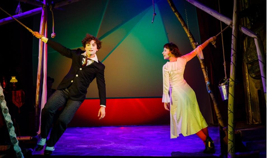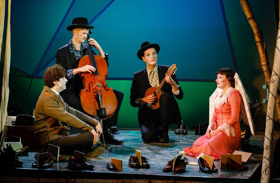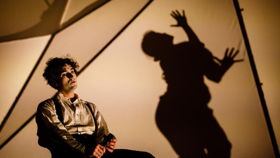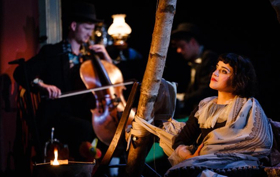Review: THE FLYING LOVERS OF VITEBSK Mystically Presents the Colorful World of Artist Marc Chagall and His Wife Bella

No one painted love like Marc Chagall. He once said, "In our life there is a single color, as on an artist's palette, which provides the meaning of life and art. It is the color of love." On Chagall canvases, couples sweep each other off their feet and up into the air. They soar over cities, arm in arm, leaving the rest of the world behind them. They are, one critic reckons, "a banner to collective love." As it turns out, his inspiration was based on the many struggles he and his wife Bella faced during the early years of their marriage when their overwhelming love for each other kept the element of sanity in an outside world gone mad.
 The magical world of artist Marc Chagall and his wife Bella is being tenderly brought to life onstage at the Wallis Annenberg Center for the Performing Arts (The Wallis) in director Emma Rice's production of Daniel Jamieson's THE FLYING LOVERS OF VITEBSK. The married couple were the original Marc and Bella in the world premiere of their play, a fitting tribute to two people in love created by two people in love.
The magical world of artist Marc Chagall and his wife Bella is being tenderly brought to life onstage at the Wallis Annenberg Center for the Performing Arts (The Wallis) in director Emma Rice's production of Daniel Jamieson's THE FLYING LOVERS OF VITEBSK. The married couple were the original Marc and Bella in the world premiere of their play, a fitting tribute to two people in love created by two people in love.
Perhaps more widely known for his artistic contributions in Nice, France during his later life, Chagall was a leading pioneer of modern art whose vibrant, original style evolved against one of the most tumultuous and terrifying periods in history. Chagall and his young wife met and fell in love in Vitebsk, Belarus in 1909, and almost immediately were swept up in the confusion and brutality of world wars, revolution,  ethnic persecution and the murder and exile of millions.
ethnic persecution and the murder and exile of millions.
Partners in life and on canvas, Jamieson has immortalized Marc and Bella as the picture of romance amid the chaotic world around them. They're the color in each other's lives; vivid pink and bright green as, bit by bit, the two become one. His ambition and art, however, pulled them apart when the more educated Bella, a highly skilled writer, was forced to stay indoors writing journals while Chagall went to work painting for at least 11 hours per day just to make enough money to keep them alive and fed.
 For me, the most artistically romantic scenes take place during those moments when Bella shares how her life is dull in black and white until Marc returns home and brings color back into her world until he leaves again the following morning. Under Rice's wondrous direction and Malcolm Rippeth's colorful lighting design, you can feel the excitement of their love to the very depths of your soul.
For me, the most artistically romantic scenes take place during those moments when Bella shares how her life is dull in black and white until Marc returns home and brings color back into her world until he leaves again the following morning. Under Rice's wondrous direction and Malcolm Rippeth's colorful lighting design, you can feel the excitement of their love to the very depths of your soul.
Marc Antolin and Daisy Maywood brilliantly and enthusiastically portray Marc and Bella whose journey is underscored throughout  with live klezmer music inspired by Russian folk tradition, composed and performed by Ian Ross and James Gow who often play characters in the show as well. Their musical contributions add a real element of historical accuracy as Marc and Bella's upbringing is shared through memories infused with the music and dance of the Russian-Jewish tradition, which lit the darkest nights in Eastern European as religious bigotry separated friends and neighbors in the early 20th Century. But it is the overwhelmingly realistic love as portrayed by Antolin and Maywood that carries the show to artistic heights!
with live klezmer music inspired by Russian folk tradition, composed and performed by Ian Ross and James Gow who often play characters in the show as well. Their musical contributions add a real element of historical accuracy as Marc and Bella's upbringing is shared through memories infused with the music and dance of the Russian-Jewish tradition, which lit the darkest nights in Eastern European as religious bigotry separated friends and neighbors in the early 20th Century. But it is the overwhelmingly realistic love as portrayed by Antolin and Maywood that carries the show to artistic heights!
 Chagall's new modern take on art, as well as the disparity of the outside world without color as opposed to his vibrantly colorful canvasses indoors, is exemplified in the stylistic presentation of the show, reflected not only in Sophia Crist's scenic and costume design, but in the choice to have the characters appear in white face like street mimes. This visual reminder of what was going on outside the world around them as opposed to the wondrous love experienced within exemplifies the soul of Jamieson's play.
Chagall's new modern take on art, as well as the disparity of the outside world without color as opposed to his vibrantly colorful canvasses indoors, is exemplified in the stylistic presentation of the show, reflected not only in Sophia Crist's scenic and costume design, but in the choice to have the characters appear in white face like street mimes. This visual reminder of what was going on outside the world around them as opposed to the wondrous love experienced within exemplifies the soul of Jamieson's play.
 In telling the story of Chagall's love for Bella Rosenfeld, whom he pictured flying with him above wooden shtetl roofs, the show captures the breathless soaring of souls set free. It also recovers the almost forgotten voice of Bella, dead from a viral infection in her 50s, whose work as a writer was overshadowed by her husband's during her lifetime as Chagall's response to the carnage around them led to him in creating his radical original visual style which was both mythic and dreamlike, fusing everyday settings inspired from Vitebsk in an extraordinary mystical lament, conveying love, loss, exile and the miracle of survival.
In telling the story of Chagall's love for Bella Rosenfeld, whom he pictured flying with him above wooden shtetl roofs, the show captures the breathless soaring of souls set free. It also recovers the almost forgotten voice of Bella, dead from a viral infection in her 50s, whose work as a writer was overshadowed by her husband's during her lifetime as Chagall's response to the carnage around them led to him in creating his radical original visual style which was both mythic and dreamlike, fusing everyday settings inspired from Vitebsk in an extraordinary mystical lament, conveying love, loss, exile and the miracle of survival.
 The Kneehigh and Old Vic production delicately expresses the way the world weighs us down by circumstances out of our control. And just as Chagall's modern expressionistic style of painting wowed audiences, the modern staging of THE FLYING LOVERS OF VITEBSK will dazzle and amaze audiences with its mystical, musical and modern dance filled presentation of the love which allowed these two creative souls to survive together in a world filled with murder and mayhem.
The Kneehigh and Old Vic production delicately expresses the way the world weighs us down by circumstances out of our control. And just as Chagall's modern expressionistic style of painting wowed audiences, the modern staging of THE FLYING LOVERS OF VITEBSK will dazzle and amaze audiences with its mystical, musical and modern dance filled presentation of the love which allowed these two creative souls to survive together in a world filled with murder and mayhem.
 THE FLYING LOVERS OF VITEBSK is making its U.S. debut at the Wallis after selling out London's Globe Theatre, as well as winning the Carol Tambor Best of Edinburgh Festival Award for 2017. Performances continue through Sunday, March 11, 2018 on Tues - Fri at 7:30pm; Sat - Sun at 2pm & 7:30pm. Running time is 2 hours and 15 minutes including a 15-minute intermission. Single tickets are $35 - $125, available online at TheWallis.org/Lovers, by phone at 310.746.4000, or in person at the Wallis Annenberg Center for the Performing Arts box office located at 9390 N. Santa Monica Blvd., Beverly Hills, CA 90210.
THE FLYING LOVERS OF VITEBSK is making its U.S. debut at the Wallis after selling out London's Globe Theatre, as well as winning the Carol Tambor Best of Edinburgh Festival Award for 2017. Performances continue through Sunday, March 11, 2018 on Tues - Fri at 7:30pm; Sat - Sun at 2pm & 7:30pm. Running time is 2 hours and 15 minutes including a 15-minute intermission. Single tickets are $35 - $125, available online at TheWallis.org/Lovers, by phone at 310.746.4000, or in person at the Wallis Annenberg Center for the Performing Arts box office located at 9390 N. Santa Monica Blvd., Beverly Hills, CA 90210.
Reader Reviews

Videos

